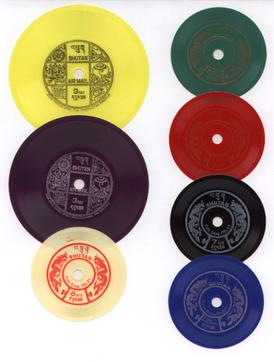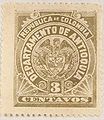Postage stamps
Antioquia became a sovereign state in 1858, by recognition as Estado de la Federación in the constitution of the Granadine Confederation. Antioquia issued its first postage stamps on September 1 1868. A postal exchange agreement with the sovereign state of Bolívar was established a few years later. With the Constitution of 1886, the sovereign state became a department, along with all the other states of Colombia, but they continued with their postal services and stamps until 1906, when the national government took over all the services previously performed by the departments.
The small quantity of stamps issued, the lithographic printing and the variety of papers used make Antioquia a very special and interesting area of Colombian philately. With many stamps no complete sheet exists and with some stamps the largest multiple is only a pair. There was often a very small quantity of stamps printed, only 258 of some and no more than 1,000 of others. Covers of that period are even scarcer than the classic Colombian covers that are recorded.
Only very few hand stamps (postal markings) were used, and most stamps were cancelled in manuscript with the name of the town of origin. [1]

Philately is the study of postage stamps and postal history. It also refers to the collection and appreciation of stamps and other philatelic products. While closely associated with stamp collecting and the study of postage, it is possible to be a philatelist without owning any stamps. For instance, the stamps being studied may be very rare or reside only in museums.

A postage stamp is a small piece of paper issued by a post office, postal administration, or other authorized vendors to customers who pay postage. Then the stamp is affixed to the face or address-side of any item of mail—an envelope or other postal cover —which they wish to send. The item is then processed by the postal system, where a postmark or cancellation mark—in modern usage indicating date and point of origin of mailing—is applied to the stamp and its left and right sides to prevent its reuse. Next the item is delivered to its addressee.

Stamp collecting is the collecting of postage stamps and related objects. It is an area of philately, which is the study of stamps. It has been one of the world's most popular hobbies since the late nineteenth century with the rapid growth of the postal service, as a stream of new stamps was produced by countries that sought to advertise their distinctiveness through their stamps.

An overprint is an additional layer of text or graphics added to the face of a postage or revenue stamp, postal stationery, banknote or ticket after it has been printed. Post offices most often use overprints for internal administrative purposes such as accounting but they are also employed in public mail. Well-recognized varieties include commemorative overprints which are produced for their public appeal and command significant interest in the field of philately.

Indian postal systems for efficient military and governmental communications had developed long before the arrival of Europeans. When the Portuguese, Dutch, French, Danish and British conquered the Marathas who had already defeated the Mughals, their postal systems existed alongside those of many somewhat independent states. The British East India Company gradually annexed the other powers on the sub-continent and brought into existence a British administrative system over most of modern-day India, with a need to establish and maintain both official and commercial mail systems.

The postage stamps and postal system of the Confederate States of America carried the mail of the Confederacy for a brief period in U.S. history. Early in 1861 when South Carolina no longer considered itself part of the Union and demanded that the U.S. Army abandon Fort Sumter, plans for a Confederate postal system were already underway. Indeed, the Confederate Post Office was established on February 21, 1861; and it was not until April 12 that the American Civil War officially began, when the Confederate Army fired upon U.S. soldiers who had refused to abandon the fort. However, the United States Post Office Department continued to handle the mail of the seceded states as usual during the first weeks of the war. It was not until June 1 that the Confederate Post Office took over collection and delivery, now faced with the task of providing postage stamps and mail services for its citizens.

A philatelic cover is an envelope prepared with a stamp(s) and address and sent through the mail delivery system for the purpose of creating a collectible item. Stamp collectors began to send mail to each other and to themselves early on, and philatelic mail is known from the late 19th century onward. While some collectors specialize in philatelic covers, especially first day covers and cacheted covers, others regard them as contrived objects that are not reflective of real-world usage, and often will pay a higher price for a cover that represents genuine commercial use. However, mail sent by stamp collectors is no less a genuine article of postage than is mail sent with no concern of seeing the mailed item again. Philatelic covers include mail from first airmail flight and first day of stamp issues ceremonies. Over the years there have been numerous Expositions where special postmarks are made and where a post office is set up where mail can be sent from on the given date of the Expo'. Like any other genuine item of mail these covers include postage stamps and postmarks of the time period and were processed and delivered by an official postal system. Often a philatelic cover will have more historical significance than randomly mailed covers as philatelic covers are also often mailed from the location on the date of an important or noteworthy event, like an inauguration or a space launch.

Postage stamp design is the activity of graphic design as applied to postage stamps. Many thousands of designs have been created since a profile bust of Queen Victoria was adopted for the Penny Black in 1840; some designs have been considered very successful, others less so.

The Mexican postal system has its roots in the Aztec system of messengers which the Spanish adopted after the Conquest. A postal service was established in 1580, mainly to communicate between the viceroyalty of New Spain with the motherland Spain. During the 18th century, Spain established a formal postal system with regular routes. In 1856, Mexico issued its first adhesive postage stamps, with "district overprints", a unique feature among postal systems worldwide, employed to protect from theft of postage stamps.

The United Nations Postal Administration (UNPA) is the postal agency of the United Nations. It issues postage stamps and postal stationery, denominated in United States dollars for the office in New York, in Swiss francs for the office in Geneva and in euros for the office in Vienna. As such, UNPA is the only postal authority that issues stamps in three different currencies.

The postage stamps of Ireland are issued by the postal operator of the independent Irish state. Ireland was part of the United Kingdom of Great Britain and Ireland when the world's first postage stamps were issued in 1840. These stamps, and all subsequent British issues, were used throughout Ireland until the new Irish Government assumed power in 1922. Beginning on 17 February 1922, existing British stamps were overprinted with Irish text to provide some definitives until separate Irish issues became available within the new Irish Free State. Following the overprints, a regular series of definitive stamps was produced by the new Department of Posts and Telegraphs, using domestic designs. These definitives were issued on 6 December 1922, the day that the Irish Free State officially came into existence; the first was a 2d stamp, depicting a map of Ireland. Since then new images, and additional values as needed, have produced nine definitive series of different designs.

Postage stamps and postal history of the Canal Zone is a subject that covers the postal system, postage stamps used and mail sent to and from the Panama Canal Zone from 1904 up until October 1978, after the United States relinquished its authority of the Zone in compliance with the treaty it reached with Panama.

Cundinamarca is a department of Colombia, one of the original nine states of the "United States of Colombia".

In general, philatelic fakes and forgeries are labels that look like postage stamps but have been produced to deceive or defraud. Learning to identify these can be a challenging branch of philately.

The postal history of Malta began in the early modern period, when pre-adhesive mail was delivered to foreign destinations by privately owned ships for a fee. The earliest known letter from Malta, sent during the rule of the Order of St John, is dated 1532. The first formal postal service on the islands was established by the Order in 1708, with the post office being located at the Casa del Commun Tesoro in Valletta. The first postal markings on mail appeared later on in the 18th century.

The first postage stamps of Bhutan were issued in 1962, the same year that the first motorable road was opened. Before that there was a mail delivery system in place for official mail using mail runners, and between 1955 and 1962 revenue stamps were accepted as payment for internal mail. With the opening up of Bhutan in the early 1960s, a formal postal system was introduced.

Colombia is a country in north-western South America. Colombia is bordered by Venezuela, Brazil, Ecuador, Peru, Panama and the Caribbean Sea and the Pacific Ocean. With a population of over 45 million people, Colombia has the second largest population in South America, after Brazil. The capital is Bogotá.

Panama was formerly a department of Colombia and used overprints of Colombian stamps from 1878 until it gained independence in 1903. However, from 1903 to 1905 sets of stamps with overprints were still used and it was only in 1906 that the first printed stamps by the Panamanian postal administration were produced with República de Panamá.

This is a survey of the postage stamps and postal history of Tuvalu.

The U.S. Parcel Post stamps of 1912–13 were the first such stamps issued by the U.S. Post Office Department and consisted of twelve denominations to pay the postage on parcels weighing 16 ounces and more, with each denomination printed in the same color of "carmine-rose". Their border design was similar while each denomination of stamp bore its own distinctive image in the center (vignette). Unlike regular postage items, whose rates were determined by weight in ounces, Parcel Post rates were determined and measured by increments in pounds. The new stamps were soon widely used by industry, farmers and others who lived in rural areas. Partly owing to some confusion involving their usage, their exclusive use as Parcel Post stamps proved short lived, as regular postage stamps were soon allowed to be used to pay parcel postage rates.
























